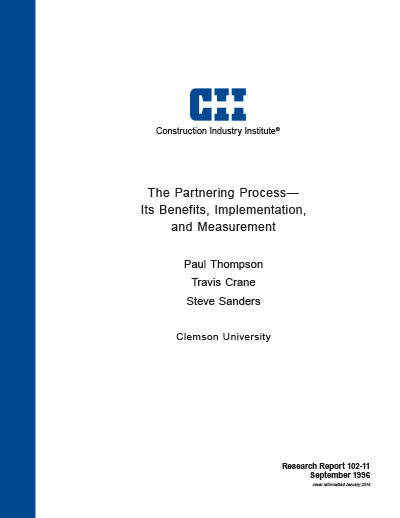
The Partnering Process -- Its Benefits, Implementation and Measurement
The engineering and construction industry has changed significantly within recent years. Increased competition and the constant push to improve capital productivity has led many owner organizations to seek innovative solutions to capture additional market share, decrease cost and schedule, or better use new technology. As well, participants in engineering and construction projects have experienced an alarming trend towards adversarial relationships of late. This adversarial environment has encouraged the use of legal remedies to resolve disputes, which, in turn, has eroded profit margins and strained or severed relationships among those involved. To combat such unproductive pursuit, attempts have been made to foster improved relations among the players involved in project development.
One successful management method that helps both to provide innovative solutions and better resolve conflict is known as “Partnering.” This method of proactively addressing potential problems, sharing business objectives, communicating with openness, and working together for common goals has resulted in many noteworthy accomplishments. Despite such accomplishments, however, the implementation of this management strategy is often hampered by internal barriers, reluctance to change, and a lack of understanding of how to implement and manage a successful partnering relationship.
In 1993, the Construction Industry Institute (CII) established the Partnering II Research Team to supplement the findings of the original CII Partnering Task Force. The new objectives were to measure the broad effects of partnering, both long term and project specific, and to establish benchmarks related to partnering. To achieve this objective, the research team established the following goals:
- Determine partnering benchmarks for the construction industry
- Evaluate current partnering efforts to identify key success factors and barriers
- Develop a set of measures for assessing the benefits of partnering
The research led to the creation of the Partnering Process Model, which identifies a five-phase process for developing and managing a partnering relationship. The model begins with the owner’s internal assessment, which includes an evaluation of partnering, including cost of implementation, potential benefits, and selection of the type of partnering desired. The next phase of the model is the creation of a selection process to aid the owner in choosing the optimum partner by applying the criteria developed in the first phase. The third phase addresses the planning and implementation of partnering at the alliance level. The key components of this phase are the development of win/win alliance objectives, and measures and incentives that support these objectives. The fourth phase of project alignment seeks to develop project specific objectives, and to align project with alliance objectives if the project is part of a strategic alliance. The final phase of work process alignment recognizes the need for management of the partnering relationship at all organizational levels, and seeks to promote a consistency of message throughout all organizations involved in the relationship.
The Partnering Process Model is a tool to be used by those either considering or already involved in partnering to understand the principles that lead to a successful relationship. The model suggests adherence to a step-by-step process and the development of relation-specific measures to achieve success through partnering. The sample measures provide guidance on how to best manage the relationship to achieve the optimum performance. These three results, based on the research team’s goals, provide the guidance needed to develop, implement, and manage a successful partnering relationship.


